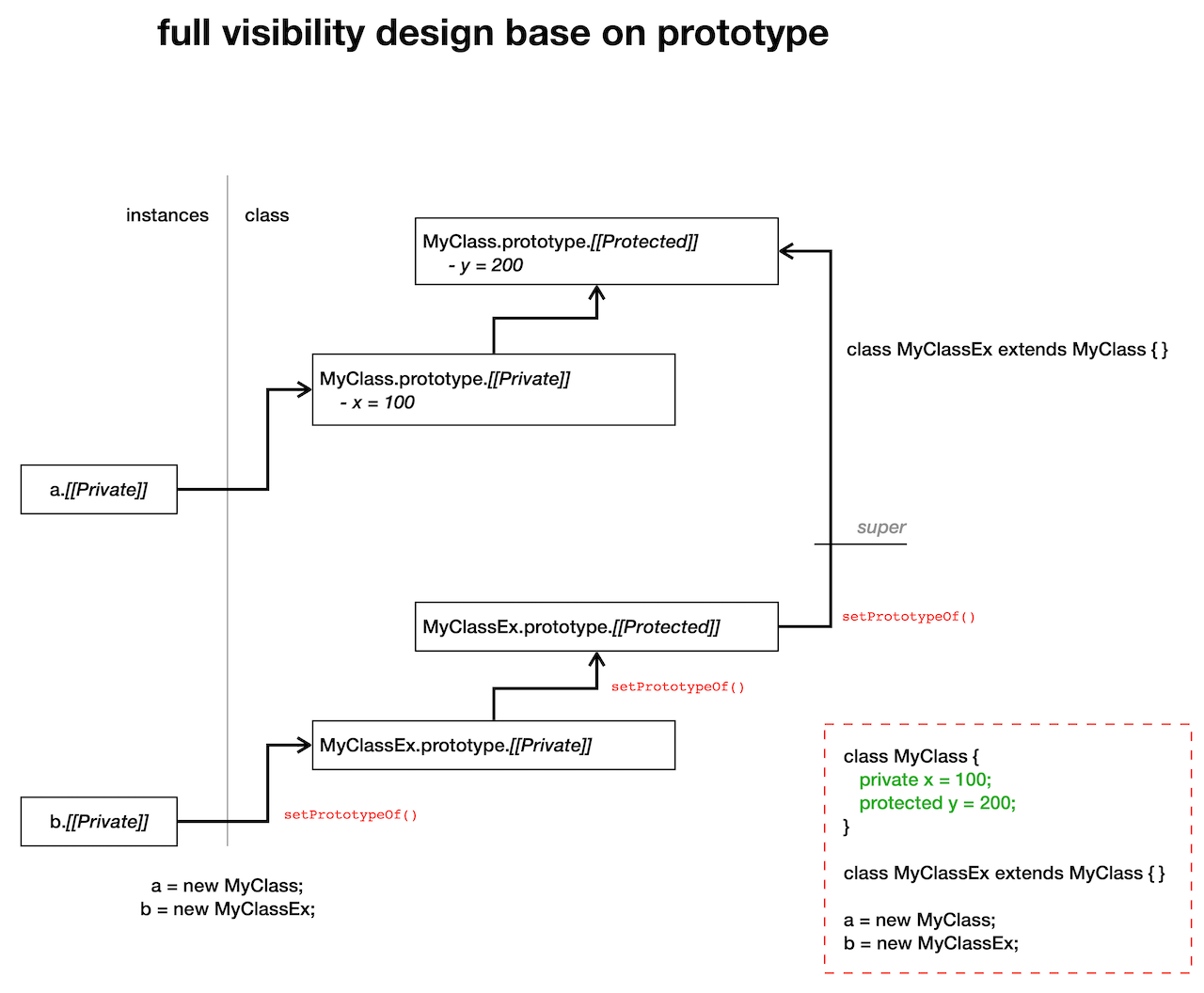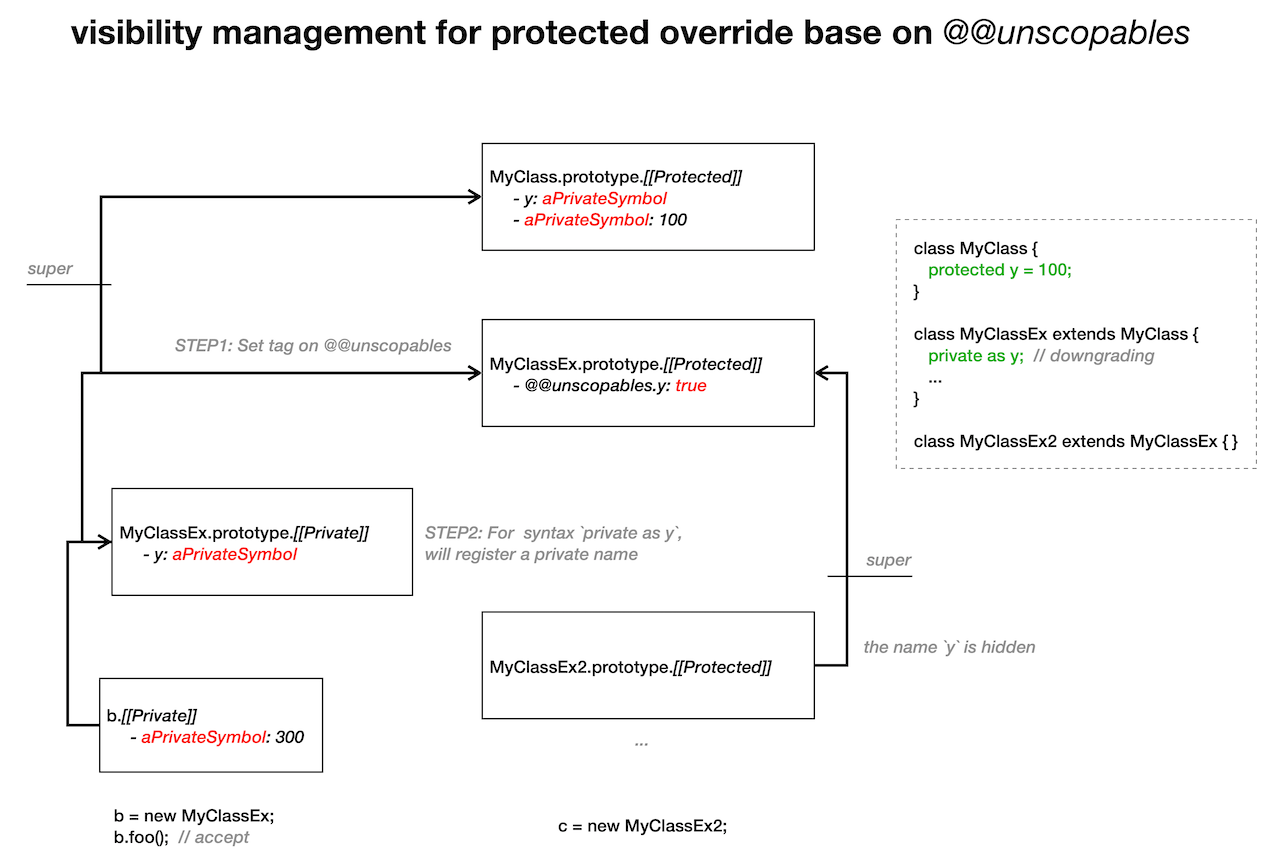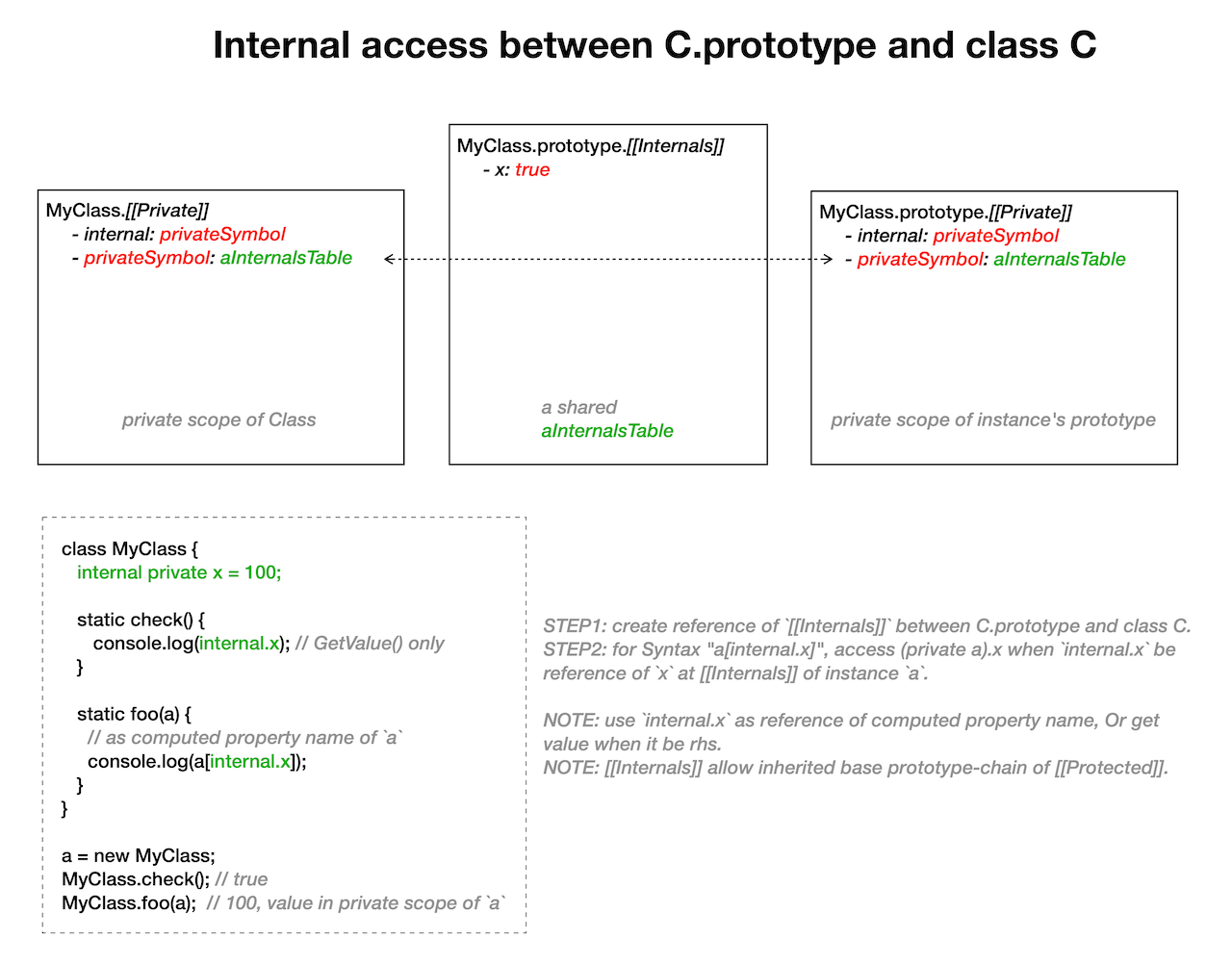The goal of this proposal is to replace the highly controversial old proposal "proposal-class-fields"(@here).
The new proposal with a concise implementation and aims to propose and accomplish the following objectives:
-
No Fields!
No new components into the ECMAScript specification.
-
Syntax beautiful, and friendly concepts, predictable design.
Concept
private propertyare current ECMAScript spec compatibled. -
Easy to implement.
And makes it easy to implement the
protectedandpublic. -
Less changes.
Simple first!
The proposal is not tc39 formal now. but have a implement at prepack-core with proposal-private-property (@here).
You can try testcase in current project (@here).
1. define private property in class definition and object literals
Use private as qualifier to definition property. The syntax is:
-
<private> [static] name [= value] [, …]
-
<private> [static] [get | set] methodName ( argumentsList ) { … }
NOTE: Why use
privatequalifier, not#prefix or sigil? hereNOTE: Support async and generator methods.
The protected and public are activation now. at here.
Examples:
// property define in class syntax
// (NOTE: `private` use statement syntax, similar to `var`)
class f {
// private property for per-instances
private data = 100;
// private property for class
private static data = 200;
// declaration list (maybe)
private x, y, z = 100;
...
}
// method and accessor define in class syntax
class f {
private get data() { ... };
private foo() { ... };
// for static ...
...
}
// in object literal definition
obj = {
// `private` is qualifier
private data1: 100,
private data2,
private get data3() { ... },
// normal
data1: 100,
...
}2. access privated properties
Read reference using identifier or propertyName without this:
- Identifier: IdentifierName but not ReservedWord.
class f {
private x;
foo() {
console.log(x); // accept
}
}Access private scope with his instances:
-
<internal> private name...
set
internalprefix modifier when class private member definition. -
instance[internal.name]
the syntax same of computed property.
NOTE: the implement of conceptual syntax
(private this).x, informal suggest.NOTE: as a conceptual depiction, the
xequ(private this).x.
class MyClass {
internal private x;
compare(b) {
return x === b[internal.x];
}
static compare(a, b) {
return a[internal.x] === b[internal.x];
}
}Or publish it:
NOTE: Simple publish private property with normal class definition. (Maybe extended to
public as x.)
// ex: publish with same name
class MyClass {
private x = 100;
get x() { // accept
return x;
}
}
a = new MyClass;
console.log(a.x); // 100The private property is object instance's private member, it define in class definition and object literals. Normal property is public member and published. They are different member of private and public scope of object instance.
Private property can only be accessed in method of class and object of them definition lexical. For classes inheritance tree, it's non-inherited and invisible. In runtime, Private scope is a ObjectEnvironment create by [[Private]] internal solt of its home object, that is method's [[HomeObject]]. All method running in this environment, but the read-write operations happen on the [[Private]] internal solt of the instance self.
NOTE: Object environment is safe at here. @see here
Protected property define in private scope too, but it's inherited and visible. @see here
The (private a).x is syntax to depiction private scope access procedure of instances a, It means,
- The object
ahas a private scope andxis a member in the scope. - The conceptual syntax
(private a).xmust express as a reference aboutx, to read (rhs) and assignment(lhs).
The concept restricts (private a).x to be used only for prototype methods or static methods in class declarations, and only allows it to access the private domain of instances of the class in the context of the above methods.
The conceptual syntax only indicates the existence of the private scope of a, and does not express how the private scope is managed, and does not indicate that concept when above reference is passed to the outside (class, instance, or domain of other entities).
Note: The
obj.#xgrammar is a implement of the conceptual syntax, because it is equivalent to(private obj).xin the case where the private scope is own by objecta. But if the private scope is part of a class's scope, it is not equivalent to(private a).x.
Note: That based on the understanding of prototype inheritance,
private propertyinterpretsmemberas "property". Which is an implementation choice, and the conceptual syntax here does not assume thatxis private "object properties".
Can read/write private scope of instances in them class, this is called Internal Access Privilege or IAP. For IAP, hard define / explicit indication are necessary, although not in some languages. Because current proposal base on these principles:
- not possible to access a private member of an object when his Class unaware. so,
- not possible to directly access private scope outside of the Class declaration.
NOTE: using
internalprefix to set IAP of private property, and useintenal.xto reference it.
The solution includes 3 key designs.
-
First of all, this is a structure that achieves complete visibility, based on prototype inheritance, without a conceptual burden.
-
Next, secure access is a simple private symbol exchange. It only needs 3 access rules to achieve.
-
Finally, the visibility override (or overload) is the markup at @@unscopables. This only takes two steps.
In addition, for the implementation of the (private a).x syntax, pls refer to this:
NOTE: Base on existing design of es6 class, the private domain (of instances and their class) is two separate, unconnected domains , which is why [[Internals]] is shared.
Core rules:
- Identifier resolve by name of private property but internal access will use private symbol key.
AClass.prototypeandAClasshas[[Private]]and[[Protected]]when them created at ClassDefinitionEvaluation phase, but a instance has[[Private]]only when it create bynew AClass().
Key implementation steps:
-
IsPrivateEnvironment(env)
If ObjectEnvironment create by
[[Private]]object, Return true,Else Return false.
-
in ClassDefinitionEvaluation
For each
private ...defines, create properties atAClass.prototype.[[Private]]by name with a symbol as value. next, create a property use this symbol as key, its value from define statement. -
before call OrdinaryCallBindThis() in [[Construct]] of Function Objects
obj.[[Private]] = Object.create(AClass.prototype.[[Private]]); -
in [[Call]] of ECMAScript Function Objects
If
F.[[HomeObject]]is present, let env be NewObjectEnvironment withF.[[HomeObject]].[[Private]], and setenv.withEnvironmentto true,env.privateBasetothis.Set the outer lexical environment reference of current-environment to env.
-
rename IsSuperReference() to IsSuperOrPrivateReference();
-
in GetIdentifierReference() If IsPrivateEnvironment(env), set
ref.thisValuetoenv.privateBasewhen resolved bindingref. -
in GetValue(V)
Let env be
GetBase(V).If IsPrivateEnvironment(env), let thisObject be GetThisValue(V), let privateSymbol be resolved value in env.WithBaseObject() with GetReferencedName(env).
Return thisObject.[[Private]].[[Get]](privateSymbol, thisObject).
Note: Return the value of
baseObject.[[Private]].xfirst when thisObject is subclass instance of [[HomeObject]] of current method and thisObject has not namex. -
in PutValue(V, W)
Let env be
GetBase(V).If IsPrivateEnvironment(env), let thisObject be GetThisValue(V), let privateSymbol be resolved value in env.WithBaseObject() with GetReferencedName(env).
Let x be resolved descriptor in env.WithBaseObject() with privateSymbol, and let parent be resolved object.
-
If privateSymbol is not ownKey of thisObject.[[Private]]
- If x is not reference descriptor, add a new data descriptor to thisObject.[[Private]] with value W.
- Else call parent.[[Set]](privateSymbol, W, thisObject)
-
Else let parent be thisObject.[[Private]], x be descriptor of parent.[privateSymbol]. and
- If x is not reference descriptor, call parent.[[Set]](privateSymbol, W, parent)
- Else call parent.[[Set]](parentSymbol, W, thisObject)
-
Done.
NOTE: Set
env.withEnvironmentto true because it will be used when implementing the protected property.NOTE: Maybe, A method can support the immutable binding objectEnvironment created with its [[HomeObject]] in MakeMethod(). But if env is immutable, then you cannot use
env.privateBaseto pass thisArgument. The good thing is that you don't need to modify the [[call]] internal method to support the runtime dynamic insertion of the objectEnvironment.NOTE: (Continue note6,) If not use
env.privateBase, we can resolvethisobject from call stack similar to a SuperPropertyReference.
Implementation steps:
-
in SuperCall()
Update result.[[Private]] to newTarget.prototype.[[Private]] after constuct from parent's constructor() method. and, the result must be instanceof newTarget.
-
in [[Call]] of ECMAScript Function Objects
Accept when thisArgument is null when bind object to private scope.
Done.
Limit rules:
internalis explicit indication for private members, ex:internal private x = 100;. That will lead to a name/value pairx: trueput into private propertyinternalwhen ClassDefinitionEvaluationinternal.xwill get a reference of private key of instance, but can't access value using that keya[internal.x]will access private scope and read/write private value of instanceawith its private keyinternal.x, these are equ conceptual syntax(private a).x
Implementation steps:
-
in ClassDefinitionEvaluation
Let
internalsbe a new Object, setinternals.[[isInternal]]to true, and letAClass.prototype.[[Internal]]to beinternals. Next, for eachinternal private ...defines, create properties atAClass.prototype.[[Internal]]by his name withtruevalue. -
when member access of evaluation MemberExpression with computed property expression (es6id: 12.3.2.1)
NOTE: the action will try r/w using reference of
a[internal.x], at this time,inernal.xis a computed propertyNameReference, so thea[internal.x]syntax is alone syntax struct, no other dependences and will return a result of him.Let
baseValuebe GetValue(baseReference), the baseReference is result of evaluating MemberExpression. ex: that is 'a' ofa[internal.x].Let
isInternalbe true when propertyNameReference is a object reference of[[internal]], else false. Return direct value of propertyNameinternal.xof objectawhenisInternalis not true.Let
basebe current method's [[HomeObject]] value, if method is static, then let to be[[HomeObject]].prototype.Let
privateNamebe GetReferenceName(propertyNameReference). ex: that is 'x' ofinternal.x.Let
privateEnvbe a new ObjectEnvironmentRecord create frombase.$Private. about his attributes, set privateBase bebaseVale, and withEnvironment to betrue. and outer of privateEnv is null.Return a new Reference, his
baseis privateEnv, name is privateName.NOTE: assert: The new reference is a PrivateReference.
NOTE: The privateEnv can cached for each
base.$Private.
Done.
Limit rules:
- not support
protected. - not support
private as.
Implementation steps:
- Set empty private object after ObjectCreate() for the literal
obj:obj.[[Private] = Object.create(null) - Create all private properties and methods at
obj.[[Private]]when PropertyDefinitionEvaluation().
Done.
- Class definition
- Object Literal definition(Object Initializer)
- protected property, with override
- support super call (maybe)
- destructuring assignment (maybe)
- declaration list (maybe)
- same name normal property
- in eval()
- in arrow functions
- in get/setter methods
- in inner other function type
- Why use
privateas qualifier, not#prefix or sigil?
sigil + sigil + sigil + sigil + sigil == Readability * 2**-5
prefix + prefix + prefix + prefix + prefix == Readability * 2**(-5*2)
and,If use # character, we may not be able to design the syntax of protected property.
- Why is
private propertyis safe and feasible?
-
Internal slot
[[HomeObject]]is ECMAScript component and initialzation by MakeMethod in ClassConstructor or ObjectCreate process.For methods, the
[[HomeObject]]is immutable, so usingHomeObject.[[Private]]to createObjectEnvironmentwill get a definite context. -
AClass.prototype is readonly.
So object instances can always get a valid private property chain from his internal slot, without being affected by behavior like
Object.setPrototypeOf(aClass.prototype, ...). -
ObjectEnvironment is safe in the static context of non-public object instance.
No one can get the host instance for this ObjectEnvironment, so this environment is static and secure, and there is no identifier ambiguity or violates lexical scope similar to the use of the
withstatement. @see Eich's point of view: Violates lexical scope forwithstatement.
The proposal has full test case in repository, current syntax based.
# install test framework
> mkdir node_modules
> npm install fancy-test chai mocha --no-save
# test it
> mocha
# (OR)
> bash run.sh- Objections to fields, especially the private field syntax
- The proposal should be rejected!
- My comments at #100
2019.09.19 architecture design published.
2019.09.01 IAP Implemented.
2019.08.21 first version of implement solution.
2019.07.29 new solution release.
2018.10.19 initial release.



